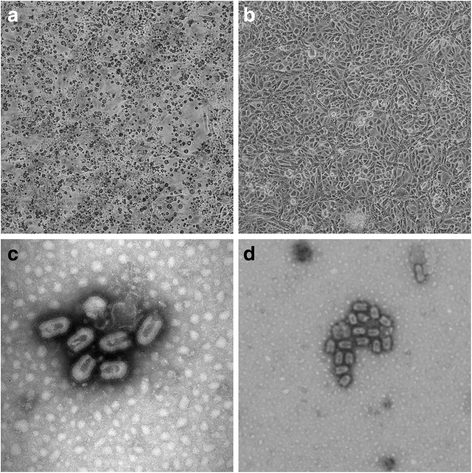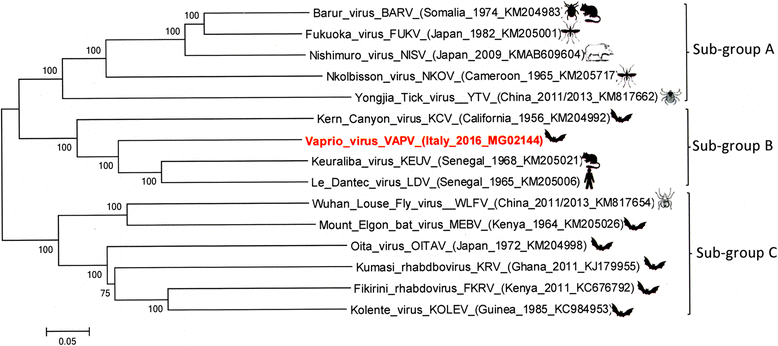Isolation of a novel Rhabdovirus from an insectivorous bat (Pipistrellus kuhlii) in Italy
- PMID: 29454370
- PMCID: PMC5816388
- DOI: 10.1186/s12985-018-0949-z
Isolation of a novel Rhabdovirus from an insectivorous bat (Pipistrellus kuhlii) in Italy
Abstract
Background: Rhabdoviridae is one of the most ecologically diverse families of RNA viruses which can infect a wide range of vertebrates and invertebrates. Bats, among mammals, are pointed to harbor a significantly higher proportion of unknown or emerging viruses with zoonotic potential. Herein, we report the isolation of a novel rhabdovirus, detected in the framework of a virological survey on bats implemented in North Italy.
Methods: Virus isolation and identification were performed on samples of 635 bats by using cell cultures, negative staining electron microscopy and PCRs for different viruses. NGS was commonly performed on cell culture supernatants showing cytopathic effect or in case of samples resulted positive by at least one of the PCRs included in the diagnostic protocol.
Results: A rhabdovirus was isolated from different organs of a Pipistrellus kuhlii. Virus identification was obtained by electron microscopy and NGS sequencing. The complete genome size was 11,774 nt comprised 5 genes, encoding the canonical rhabdovirus structural proteins, and an additional transcriptional unit (U1) encoding a hypothetical small protein (157aa) (3'-N-P-M-G-U1-L-5'). The genome organization and phylogenetic analysis suggest that the new virus, named Vaprio virus (VAPV), belongs to the recently established genus Ledantevirus (subgroup B) and it is highly divergent to its closest known relative, Le Dantec virus (LDV) (human, 1965 Senegal). A specific RT-PCR amplifying a 350 bp fragment of the ORF 6 gene, encoding for L protein, was developed and used to test retrospectively a subset of 76 bats coming from the same area and period, revealing two more VAPV positive bats.
Conclusions: VAPV is a novel isolate of chiropteran rhabdovirus. Genome organization and phylogenetic analyses demonstrated that VAPV should be considered a novel species within the genus Ledantevirus for which viral ecology and disease associations should be investigated.
Conflict of interest statement
Authors’ information
DL is a veterinary virologist at the Virology Unit of IZSLER. His activity of study and research deals with virological and serological diagnosis of viral diseases of livestock and wildlife species and in the development and validation of diagnostic tests. Emerging and zoonotic viruses, viruses associated with bats and arthropod-borne viruses are currently the major topics of his studies.
Ethics approval and consent to participate
Not applicable.
Consent for publication
Not applicable.
Competing interests
The authors declare that they have no competing interests.
Publisher’s Note
Springer Nature remains neutral with regard to jurisdictional claims in published maps and institutional affiliations.
Figures



Similar articles
-
Isolation and molecular characterization of Fikirini rhabdovirus, a novel virus from a Kenyan bat.J Gen Virol. 2013 Nov;94(Pt 11):2393-2398. doi: 10.1099/vir.0.053983-0. Epub 2013 Aug 12. J Gen Virol. 2013. PMID: 23939976
-
Molecular detection and sequence characterization of diverse rhabdoviruses in bats, China.Virus Res. 2018 Jan 15;244:208-212. doi: 10.1016/j.virusres.2017.11.028. Epub 2017 Nov 28. Virus Res. 2018. PMID: 29196194 Free PMC article.
-
Characterization of Novel Rhabdoviruses in Chinese Bats.Viruses. 2021 Jan 5;13(1):64. doi: 10.3390/v13010064. Viruses. 2021. PMID: 33466539 Free PMC article.
-
Human Tibroviruses: Commensals or Lethal Pathogens?Viruses. 2020 Feb 25;12(3):252. doi: 10.3390/v12030252. Viruses. 2020. PMID: 32106547 Free PMC article. Review.
-
The family Rhabdoviridae: mono- and bipartite negative-sense RNA viruses with diverse genome organization and common evolutionary origins.Virus Res. 2017 Jan 2;227:158-170. doi: 10.1016/j.virusres.2016.10.010. Epub 2016 Oct 20. Virus Res. 2017. PMID: 27773769 Free PMC article. Review.
Cited by
-
Bat-Borne Coronaviruses in Jordan and Saudi Arabia: A Threat to Public Health?Viruses. 2020 Dec 9;12(12):1413. doi: 10.3390/v12121413. Viruses. 2020. PMID: 33316899 Free PMC article. Review.
-
Widespread human exposure to ledanteviruses in Uganda: A population study.PLoS Negl Trop Dis. 2024 Jul 8;18(7):e0012297. doi: 10.1371/journal.pntd.0012297. eCollection 2024 Jul. PLoS Negl Trop Dis. 2024. PMID: 38976760 Free PMC article.
-
Isolation of a Novel Bat Rhabdovirus with Evidence of Human Exposure in China.mBio. 2021 Feb 22;13(1):e0287521. doi: 10.1128/mbio.02875-21. Epub 2022 Feb 15. mBio. 2021. PMID: 35164557 Free PMC article.
-
Main causes of death of free-ranging bats in Turin province (North-Western Italy): gross and histological findings and emergent virus surveillance.BMC Vet Res. 2023 Oct 11;19(1):200. doi: 10.1186/s12917-023-03776-0. BMC Vet Res. 2023. PMID: 37821925 Free PMC article.
-
Novel and Diverse Non-Rabies Rhabdoviruses Identified in Bats with Human Exposure, South Dakota, USA.Viruses. 2020 Dec 8;12(12):1408. doi: 10.3390/v12121408. Viruses. 2020. PMID: 33302422 Free PMC article.
References
Publication types
MeSH terms
Substances
LinkOut - more resources
Full Text Sources
Other Literature Sources
Research Materials

